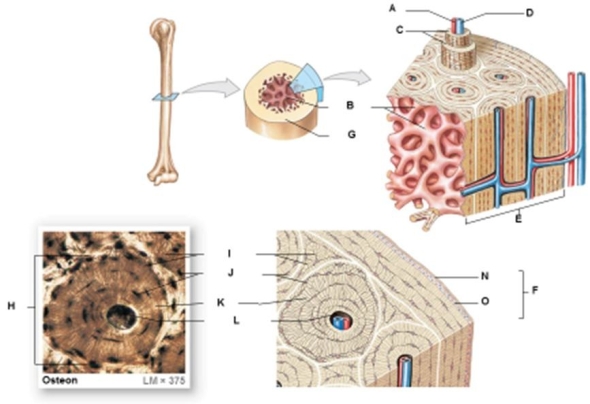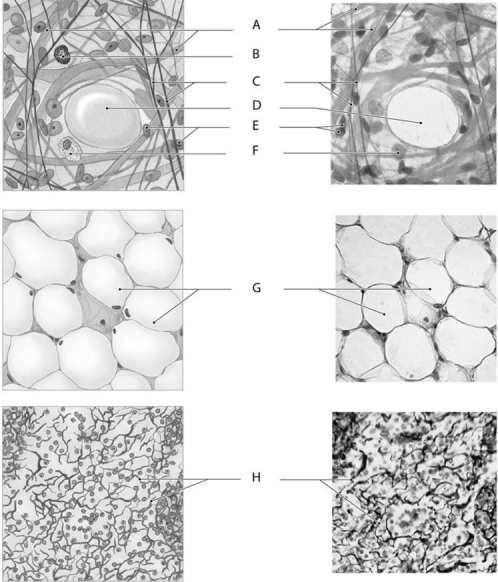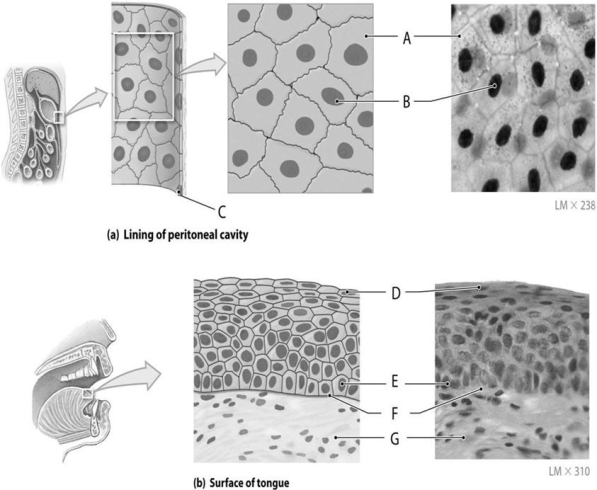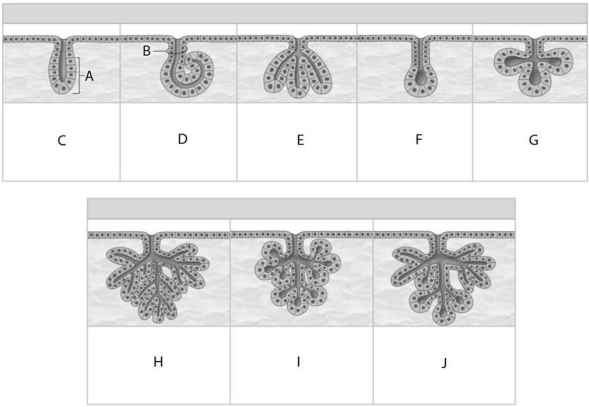A) sarcolemmae
B) intermuscular fascia
C) soma
D) intercalated discs
E) striations
G) A) and B)
Correct Answer

verified
Correct Answer
verified
Multiple Choice
Figure 3.4
 -Identify the specific structure indicated by Label N.
-Identify the specific structure indicated by Label N.
A) Basal layer
B) Subcutaneous layer
C) Lamina lucida
D) Apical layer
E) Fibrous layer
G) A) and B)
Correct Answer

verified
Correct Answer
verified
Multiple Choice
Figure 3.3
 Using the figure above, answer the following questions.
-Identify the specific structure indicated by Label G.
Using the figure above, answer the following questions.
-Identify the specific structure indicated by Label G.
A) Lymphocytes
B) Plasmocytes
C) Adipocytes
D) Monocytes
E) Phagocytes
G) B) and D)
Correct Answer

verified
Correct Answer
verified
Multiple Choice
Which of the following terms means two or more layers?
A) pseudostratified
B) columnar
C) stratified
D) cuboidal
E) simple
G) A) and D)
Correct Answer

verified
Correct Answer
verified
Multiple Choice
Synovial membranes ________.
A) consist of extensive areas of areolar tissue bounded by a basal lamina
B) consist of a cellular layer complete with tight junctions between adjacent cells
C) cover the entire surface of the body and consist of a keratinized stratified squamous epithelium and an underlying layer of areolar connective tissue that is reinforced by a layer of dense connective tissue
D) are comprised of areolar tissue component called lamina propria and often lined by simple epithelia that perform absorptive or secretory functions
E) contain "epithelial cells" derived from macrophages and fibroblasts of the adjacent connective tissue
G) A) and D)
Correct Answer

verified
Correct Answer
verified
Essay
How does a ligament differ from a tendon?
Correct Answer

verified
Tendons are cords of dense regular conne...View Answer
Show Answer
Correct Answer
verified
View Answer
Multiple Choice
Figure 3.1
 Using the figure above, answer the following questions.
-Identify the specific structure indicated by Label A.
Using the figure above, answer the following questions.
-Identify the specific structure indicated by Label A.
A) Plasma membrane
B) Matrix
C) Lamina lucida
D) Peritoneum
E) Cytoplasm
G) B) and C)
Correct Answer

verified
Correct Answer
verified
Multiple Choice
Skeletal muscle tissue contains large fibers that are ________.
A) multinucleated
B) involuntary
C) nonstriated
D) controlled by pacesetter cells
E) connected by intercalated discs
G) C) and E)
Correct Answer

verified
Correct Answer
verified
Multiple Choice
Muscle tissue located in layers around the digestive tract is called ________.
A) smooth muscle
B) crenulated muscle
C) skeletal muscle
D) cardiac muscle
E) All of the answers are correct.
G) B) and D)
Correct Answer

verified
Correct Answer
verified
Multiple Choice
Figure 3.3
 Using the figure above, answer the following questions.
-Identify the specific structure indicated by Label C.
Using the figure above, answer the following questions.
-Identify the specific structure indicated by Label C.
A) Reticular fibers
B) Ground substance
C) Elastic fibers
D) Striated muscle
E) Collagen fibers
G) B) and E)
Correct Answer

verified
Correct Answer
verified
Multiple Choice
Figure 3.1
 Using the figure above, answer the following questions.
-What type of epithelium comprises the lining of the peritoneal cavity, which is featured in the top group of diagrams (Fig. 3.1a) ?
Using the figure above, answer the following questions.
-What type of epithelium comprises the lining of the peritoneal cavity, which is featured in the top group of diagrams (Fig. 3.1a) ?
A) Simple cuboidal
B) Simple columnar
C) Simple squamous
D) Transitional
E) Stratified cuboidal
G) B) and E)
Correct Answer

verified
Correct Answer
verified
Multiple Choice
Figure 3.4
 -Identify the specific structure indicated by Label G.
-Identify the specific structure indicated by Label G.
A) Trabeculae
B) Spongy bone
C) Cutaneous membrane
D) Compact bone
E) Perichondrium
G) B) and E)
Correct Answer

verified
Correct Answer
verified
Multiple Choice
Features of smooth muscle tissue include ________.
A) its exclusive location in the heart
B) multiple nuclei (usually) for each cell
C) the presence of striations
D) intercalated discs and multinucleated
E) having a single nucleus (usually) for each cell and regenerative capabilities
G) A) and E)
Correct Answer

verified
Correct Answer
verified
Multiple Choice
Figure 3.2
 Using the figure above, identify the gland features and types.
-Identify the gland indicated by Label I.
Using the figure above, identify the gland features and types.
-Identify the gland indicated by Label I.
A) Compound branched acinar
B) Compound branched tubular
C) Compound alveolar
D) Compound tubuloalveolar
E) Compound coiled tubular
G) C) and D)
Correct Answer

verified
Correct Answer
verified
Multiple Choice
Hormones are examples of ________ secretion.
A) exocrine
B) endocrine
C) holocrine
D) merocrine
E) apocrine
G) B) and C)
Correct Answer

verified
Correct Answer
verified
Multiple Choice
Which of the following cells can be found in connective tissue?
A) mesenchymal cells
B) fibroblasts
C) eosinophils
D) mast cells
E) All of the answers are correct.
G) B) and D)
Correct Answer

verified
Correct Answer
verified
Multiple Choice
________ tissue provides a supporting framework of the liver, spleen, bone marrow, and lymph nodes.
A) Dense irregular
B) Areolar
C) Adipose
D) Elastic
E) Reticular
G) None of the above
Correct Answer

verified
Correct Answer
verified
Multiple Choice
Figure 3.4
 -Identify the specific structure indicated by Label L.
-Identify the specific structure indicated by Label L.
A) Central canal
B) Lacuna
C) Lymphatic duct
D) Canaliculus
E) Serous duct
G) A) and B)
Correct Answer

verified
Correct Answer
verified
Multiple Choice
Figure 3.1
 Using the figure above, answer the following questions.
-What type of epithelium comprises the surface of the tongue, which is featured in the bottom group of diagrams (Fig. 3.1 b) ?
Using the figure above, answer the following questions.
-What type of epithelium comprises the surface of the tongue, which is featured in the bottom group of diagrams (Fig. 3.1 b) ?
A) Stratified columnar
B) Pseudostratified columnar
C) Stratified cuboidal
D) Stratified squamous
E) Transitional
G) C) and D)
Correct Answer

verified
Correct Answer
verified
Multiple Choice
Figure 3.2
 Using the figure above, identify the gland features and types.
-Identify the gland indicated by Label G.
Using the figure above, identify the gland features and types.
-Identify the gland indicated by Label G.
A) Simple coiled acinar
B) Simple branched tubular
C) Simple tubular
D) Simple branched alveolar
E) None of the answers are correct.
G) B) and D)
Correct Answer

verified
Correct Answer
verified
Showing 101 - 120 of 127
Related Exams